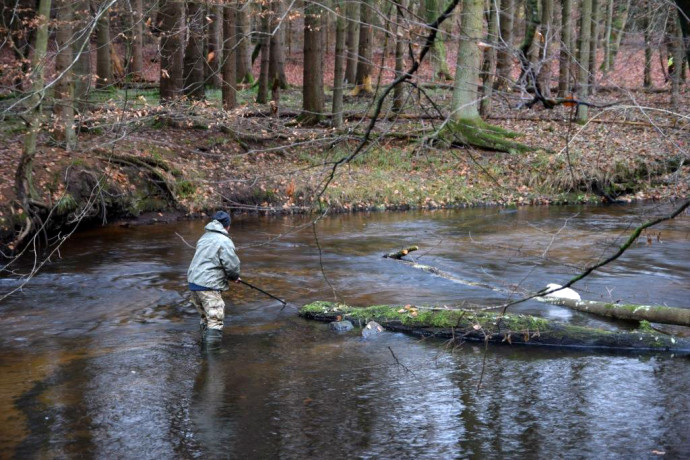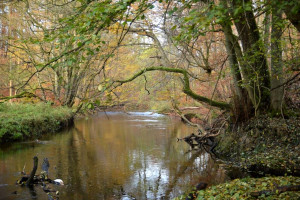Field trips in the Oder Delta reveal the potential for restoring fish migration.

In brilliant mid-November sunshine, Suleika Suntken and myself, Katrin Schikorr, arrive in the small Polish city of Stepnica, on the edge of the Oder Delta. All members of the German Rewilding Oder Delta project team from the Deutsche Umwelthilfe (DUH), we are eagerly anticipating our arrival at Artur Furdyna’s house. He has promised us spectacular natural drama – shoals of migrating fish species arriving in the Gowienica, Ina and Wołczenica rivers.
The Gowienica is one of the main tributaries of the lower Oder Delta on the Polish side, and is part of the wider Oder Delta rewilding area. While its biodiversity is still high and large parts of the river are in a natural state, the overall ecological situation could be improved, and several restoration activities are underway.
Artur Furdyna is our local partner in Poland. A fish ecologist and specialist on river and wetland restoration, he is an expert when it comes to reconnecting waterways for migrating fish species such as salmon, sea trout, maraena whitefish, lamprey and sturgeon.
Together with The Association of Friends of The Ina and The Gowienica Rivers (TPRIIG), Artur has worked since 1998 to safeguard the fish populations of the Ina and Gowienica. His main focus has been protecting riverine ecology, limiting poaching pressure on wild fish, and encouraging a more sustainable water management system, consistent with the Water Framework Directive.

Arriving at the river, vibrant autumn colours decorate the landscape. We cautiously approach the meandering Gowienica. I’m almost afraid to scare away the fish, and we try to walk without making a noise. Artur is in his element, however – he has worked here for over 20 years, improving spawning habitats for sea trout, salmon, grayling, bullhead, lampreys and other protected species. It is thanks to his efforts that the ecologically most important part of the river between Babigoszcz and Widzeńsko was recently recognized as a “no take zone” for anglers.
Artur wades through the river, getting his GoPro ready. He knows exactly where to place the camera to observe those fish that are ready to reproduce. After checking several sites, he seems dissatisfied – where are all the fish? The water should be boiling with species engaged in their mating throes.
Before driving home, we stop by a bridge construction site and Artur checks the status of ongoing work. Although he asked for the work to take place over the summer, construction started in the autumn. Perhaps this has intefered with the fish migration.
The following day we are again lucky with the weather but unlucky with migrating fish. We film one sea trout male with a partially cut caudal fin that Artur recognizes from earlier encounters. But again he seems disappointed. Are we too early in the season? Is the construction work a problem? Are poachers fishing here illegally? A couple of open questions remain.
Two weeks later Artur and myself check out some small tributaries of the Szczecin Lagoon on the German side of the Oder Delta. Here, in collaboration with the local administration for sustainable development and nature conservation, we plan to improve the riverine habitat for migrating fish populations. We especially examine one small tributary, the Teufelsgraben, entering the lagoon near Rieth, a stone’s throw from the Polish-German border.
The Teufelsgraben was built around 200 years ago to drain the Ahlbeck Lake, situated 4 kilometres to the south. The former lake area is now a legally protected wetland. Despite being artificial, the Teufelsgraben contains valuable biodiversity, with good potential for ecological improvement.
The Teufelsgraben also turns out to be the site of a wonderful surprise. Below a bridge over the waterway, we finally observe the spectacular natural drama that Artur has been craving – thousands and thousands of juvenile perch and roach! The water is churned by a mass of silver-grey bodies, with every fish struggling upriver to spawn.
The fish concentration is enormous, and we soon see why. The current here is very strong, thanks to a concrete tunnel under the bridge. With a lack of places to rest, the fish have almost no chance to navigate this obstruction.
Two neighbouring rivers – the Gowenieca and Teufelsgraben – both with artificial obstacles impeding migrating fish populations. Artur is quick to suggest simple changes to improve the situation, and we agree to forge ahead with restoration work on the Teufelsgraben. Busy times lie ahead, as well as finding solutions to the open questions at Gowenieca!
